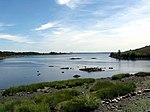Cuban Ledge
Geography of the BronxLong Island Sound
Cuban Ledge is a reef or islet composed chiefly of sand and small rocks in Eastchester Bay, the Bronx, in Long Island Sound. It is located between Rodman's Neck and Country Club in Eastchester Bay and is visible only during periods of low tide. It is a hazard to boats, and is marked with a signal tower.
Excerpt from the Wikipedia article Cuban Ledge (License: CC BY-SA 3.0, Authors).Cuban Ledge
New York The Bronx
Geographical coordinates (GPS) Address Nearby Places Show on map
Geographical coordinates (GPS)
| Latitude | Longitude |
|---|---|
| N 40.8416 ° | E -73.8037 ° |
Address
Country Club
10465 New York, The Bronx
New York, United States
Open on Google Maps









